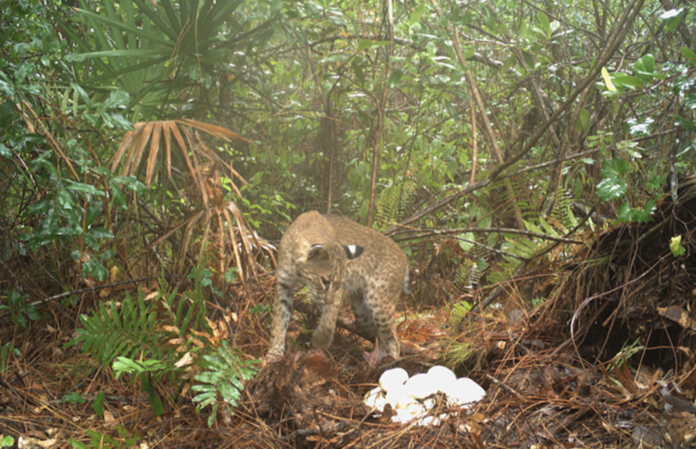Burmese pythons are at the very top of Florida’s “Most Unwanted” list. There are now 500 or so invasive species living in the Sunshine State, but none of these are as harmful as pythons. One the biggest problem with pythons, from a wildlife management standpoint, is that they have no natural predators. Wildlife biologists have never actually documented a native predator taking on a Burmese python in the wild. Until now.
In a study that was published in Ecology and Evolution last month, researchers with the U.S. Geological Survey captured photographs and videos of a bobcat tangling with a 120-pound female python that was defending her nest. The footage from the Everglades shows that after the initial face-off between the bobcat and the snake, the cat returned to the nest to feast on its eggs.
This was an important and encouraging discovery for the research team. Mainly because it shows that after all the damage that pythons have done (and continue to do) in America’s last remaining subtropical wilderness, its native inhabitants are learning to fight back.
Florida’s python problem began in the 90’s with a few careless pet owners, who released the snakes into the local swamps after realizing that maybe they didn’t want a 10- to 12-foot-long constrictor hanging out in their living room. Over the last few decades, the snakes have flourished everywhere from Miami down to the ‘Glades. They prey on endangered birds, frogs, and other reptiles. Severe declines in mammal populations have also been linked directly to the presence of these huge, invasive snakes from southeast Asia.
Current estimates of their statewide population range between 30,000 and 300,000, and this alarming growth led Florida to declare war on Burmese pythons in 2017. As part of its Python Elimination Program, the state now “incentivizes a limited number of public-spirited individuals to humanely euthanize these destructive snakes.” In other words: they’re paying people to go out and kill the slithering invaders. And while people are having success removing more and more of the snakes each year—there were 1,068 pythons captured in the last two months alone—we can’t get rid of them on our own. The Everglades wilderness, which encompasses roughly 1.5 million acres, is just too big.
Read Next: The Python Hunt
This overwhelming problem is what inspired the USGS to install a trail camera near a python nest in the Big Cypress National Preserve last June. Their goal was to simply observe the snake and gather data on the apex-predator’s life cycle, including how many eggs are laid in each clutch, and how many of these eggs survive. It wasn’t until they retrieved the motion-activated camera that they learned of the face-off between the snake and the bobcat.
An Encouraging Discovery
The male bobcat was first caught on camera at the unguarded python nest on June 1, the same day the camera was deployed. Over the next couple days, the cat was photographed “repeatedly approaching the unguarded nest and consuming, trampling, caching, and uncovering the eggs.” And on June 4, the interspecies standoff finally turned into a brawl. The photo sequence shows the python striking at the bobcat before the cat takes a swipe at the snake.
Researchers went out to the site later that day and took note of the damaged nest. Weeks later, on June 15, they returned to find the python brooding the nest, and they documented 42 destroyed eggs along with 22 damaged but “potentially viable” eggs, which they took to the lab for further testing. They left the camera in place, however, and were able to capture more photos of the cat, which returned over the next several weeks to scavenge and destroy the eggs that were left behind.

This turned out to be a remarkable discovery for researchers. Even though it meant their data-points—the eggs—were destroyed, it represented “the first recorded instance of a Burmese python actively defending a nest and the first record of a bobcat depredating a python nest.”
This documented face-off gives researchers hope that more native predators will adapt to the presence of the invasive pythons, thereby restoring some semblance of balance to an ecosystem that has long been out of whack.
“We’re hoping to see if more natives are able to recognize pythons as a food item instead of it only being one-way predation,” lead researcher Andrea Currylow told the Miami New Times on Monday. “If that’s what’s really happening, that is so crazy! The capacity of this ecosystem to rebound is really exciting.”


